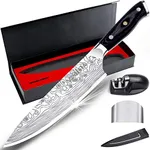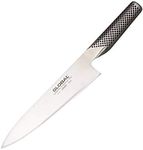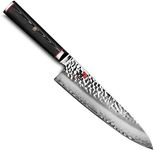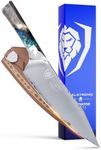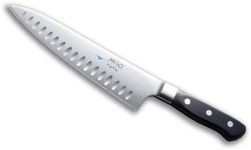Buying Guide for the Best Chefs Knives
Choosing the right chef's knife is essential for anyone who spends time in the kitchen, whether you're a beginner or an experienced cook. A good chef's knife should feel comfortable in your hand, be versatile enough to handle a variety of tasks, and stay sharp for a long time. When shopping for a chef's knife, it's important to consider several key features that affect how the knife performs and how enjoyable it is to use. Understanding these features will help you find a knife that matches your cooking style and needs.Blade LengthBlade length refers to how long the cutting edge of the knife is, usually measured in inches. Most chef's knives range from 6 to 10 inches. Shorter blades (6-7 inches) are easier to control and are great for smaller hands or for tasks like chopping herbs and small vegetables. Longer blades (8-10 inches) can handle larger ingredients and make it easier to slice through big items like melons or roasts, but they can feel unwieldy for some people. To pick the right length, consider the size of your hands and the types of food you prepare most often. If you want a versatile, all-purpose knife, an 8-inch blade is a popular and balanced choice.
Blade MaterialThe material of the blade affects sharpness, durability, and maintenance. Common materials include stainless steel, high-carbon steel, and ceramic. Stainless steel is resistant to rust and easy to maintain, making it a good choice for most home cooks. High-carbon steel can hold a sharper edge for longer but may require more care to prevent rust. Ceramic blades are very sharp and lightweight but can chip or break if dropped. Think about how much maintenance you're willing to do and whether you prefer a knife that stays sharp longer or one that's easier to care for.
Handle Comfort and MaterialThe handle is where you grip the knife, and its comfort and material can make a big difference in how enjoyable the knife is to use. Handles can be made from wood, plastic, or composite materials. Wood handles feel traditional and warm but may need more care to avoid damage from water. Plastic and composite handles are durable and easy to clean. The shape and size of the handle should fit comfortably in your hand, so if possible, try holding different knives to see what feels best. If you cook for long periods, a comfortable, non-slip handle is especially important.
Weight and BalanceWeight and balance refer to how heavy the knife feels and how the weight is distributed between the blade and the handle. Some people prefer a heavier knife for tasks like chopping dense vegetables, while others like a lighter knife for quick, precise cuts. A well-balanced knife feels stable and comfortable, making it easier to control. To find the right fit, think about your strength and the types of tasks you do most. If you can, test a few knives to see which weight and balance feel most natural to you.
Blade Shape and EdgeChef's knives usually have a curved blade that allows for a rocking motion when chopping. The edge can be smooth (straight) or have a slight serration. A smooth edge is best for most kitchen tasks, providing clean cuts on vegetables, meat, and herbs. Some knives have a more pronounced curve, which is great for rocking cuts, while others are flatter, which can be better for slicing. Consider your cutting style—if you like to rock the knife back and forth, a curved blade is ideal; if you prefer straight slicing, a flatter edge may suit you better.



